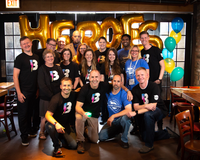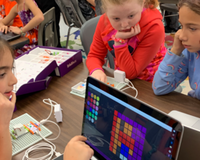STEM, the study of Science, Technology, Engineering, and Math, is an incredibly important part of modern education. In today’s digital world, understanding STEM concepts is not only essential for navigating everyday life, but also as a gateway into careers that are increasingly technology-based.
Aside from the direct benefits of STEM learning, these subjects also help students develop and hone a range of crucial secondary skills like critical thinking, problem-solving, and creativity.
It’s never too early (or too late) to start learning STEM concepts, and you don’t even need to wait for a classroom to do so. With the right resources and engaging activities, your learners can start their STEM adventure at any age, from anywhere.
Here are some of Sphero’s best educational resources for STEM learning, suitable for each age and grade level.
STEM for Kindergarten
Kindergarten is a great time to begin introducing STEM by teaching the foundations both in the classroom and at home. Here are some resources to help kindergarten-age kids start learning STEM concepts:
Solving problems is an essential building block of STEM, as well as an important life skill. In this guide, we’ll show you when to start teaching problem-solving skills and share some of our best problem-solving activities.
One of the biggest challenges with socially distanced learning is managing break times. While breaks are different from a traditional classroom, they’re still an important part of a well-structured learning schedule. In this guide, we’ll show you how to create engaging break time activities for your young learners.
Hybrid learning is more common than ever before, and keeping these classes stimulating can be a real challenge for teachers. In this guide, we’ll show you a range of creativity-boosting STEM activities to add some fun to the midweek lull.
Technology literacy is the ability to process and communicate technical information, and it’s an increasingly crucial skill in today’s world. In this guide, we’ll break down why technology literacy is important to introduce at a young age and how you can start doing so today.
STEM for Elementary Students
By elementary school, students are more capable of comprehending important STEM concepts, opening up a whole range of exciting educational opportunities. Here are some resources to help you teach STEM topics to elementary students:
In this guide, we’ve made a list of 19 STEM projects you can use to engage and teach your students important 21st Century skills from anywhere.
Our littleBits At-Home Learning Starter Kit contains everything you need to plan and teach STEAM lessons at home, including a range of activities and equipment.
The Sphero Mini robot ball is perfect for beginners, as kids can program the bot to drive and play STEM-inspired games with the Sphero Play App. This is a great way for new learners to get familiar with robotics and the practical applications of STEM.
In this guide, we’ll provide you with a mood tracker worksheet to help your students stay in touch with how they’re feeling over time.
STEM for Middle School
By middle school, your STEM learners are ready to start learning real-world computer science skills. Here are helpful resources for teaching STEM in middle school:
The littleBits STEAM+ Kit contains everything you need to engage and teach students. It includes 40+ hours’ worth of no-device-required lessons and a range of coding and engineering activities to make teaching STEAM topics easier than ever before.
Middle school is an important transition period between foundational STEM concepts and more complex and challenging subjects. In this guide, we’ll show you five activities built to help middle school students engage with and succeed in their STEM education.
Learning to code is like learning a language, and while it might seem complicated at first, it’s much easier if you start with the basics. This guide shows the coding concepts every young learner should start with for a solid foundation in the world of STEM.
Teaching from home is a challenge that many parents are facing. This guide breaks down our Computer Science Foundations course to help you easily teach STEM from home.
STEM in High School
Once your STEM learners reach high school, it’s time for them to execute learned skills and determine whether they wish to continue with a career in STEM. Here are some resources to help do so:
Sphero BOLT is our most advanced coding robotic ball and the perfect gadget to help learners at any stage of their STEM journey get to grips with the practical side of some higher abstraction coding concepts.
This programmable robot vehicle is a fun and dynamic way for your students to explore coding concepts with a ton of customizable options and advanced sensors.
To make any progress with learning STEM, it’s essential to ensure the basics are covered. This guide runs through the five crucial coding concepts every high school learner should make sure they know before moving forward.
The STEM field is home to some of the most rewarding and fastest-growing careers on the planet, from dentists to astronauts to programmers. In this guide, we’ll show you 17 STEM career ideas to inspire your high school learners to further explore the field.
Teach STEM to All Ages with Sphero
Learning STEM can be a fascinating and fun process for parents, teachers, and students of any age. It’s much easier and more rewarding when you have the right resources and support, which is why our goal at Sphero is to provide educators everything they need to make STEM accessible for any age, in any classroom or home.
Looking for more engaging lesson ideas? Visit our activities portal to discover more STEM-based activities for the classroom and home.










